This slideshow requires JavaScript.
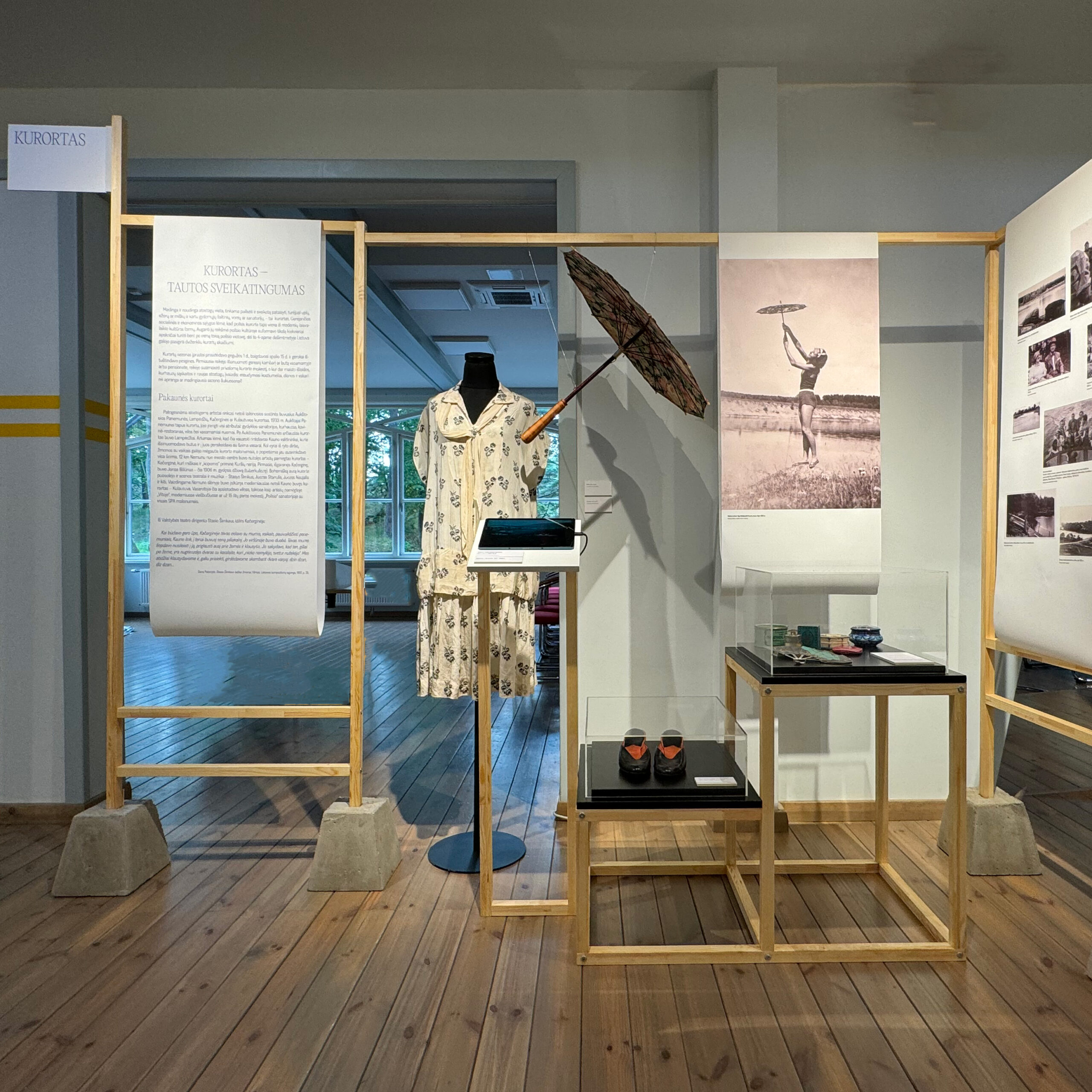
spatial designer and storyteller

The Urban Cultural Planning project was funded by Interreg and locally led by Vilnius Tech University. Together with my colleague Ineta Pliekaitytė, I took up the role of researcher and co-led monthly workshops with the Šnipiškės community. In 2020, marked by lockdown, the workshops sought ways to reach the community remotely while keeping a tactile, place-based element. We wanted to offer the community a break from the digital and create a different way to connect with us.
To introduce ourselves, together with local artist Pizinas, we produced 30 plywood cats that were placed around the neighbourhood. Each cat carried a note inviting people to take it home and participate in Cultural Probe exercises contained in envelopes attached to them. This approach gave us insights into people’s lives and allowed us to connect in a new, semi-digital way.
We also left notes, set up boxes with instructions for making Christmas decorations and Advent calendars, and encouraged small acts of kindness for neighbours.
As preparation for the spring workshop, we organised a brainstorming session where residents were invited to share their ideas for public space use. Building on this, we created a small community garden, fenced off a play area from the parking road, and knitted nests for children’s play, as well as cosy, safe spaces for rest.
Photos and video by Gvidas Bindokas and Mantas Narkevičius
Urban Cultural Planning project by Interreg
Partners in Lithuania: Vilnius Tech University, lead by Jekaterina Lavrinec
Researchers and Community Managers: Ineta Pliekaitytė and Ieva Šimkonytė
In collaboration with local artist Pijus Čeikauskas (pijinas)
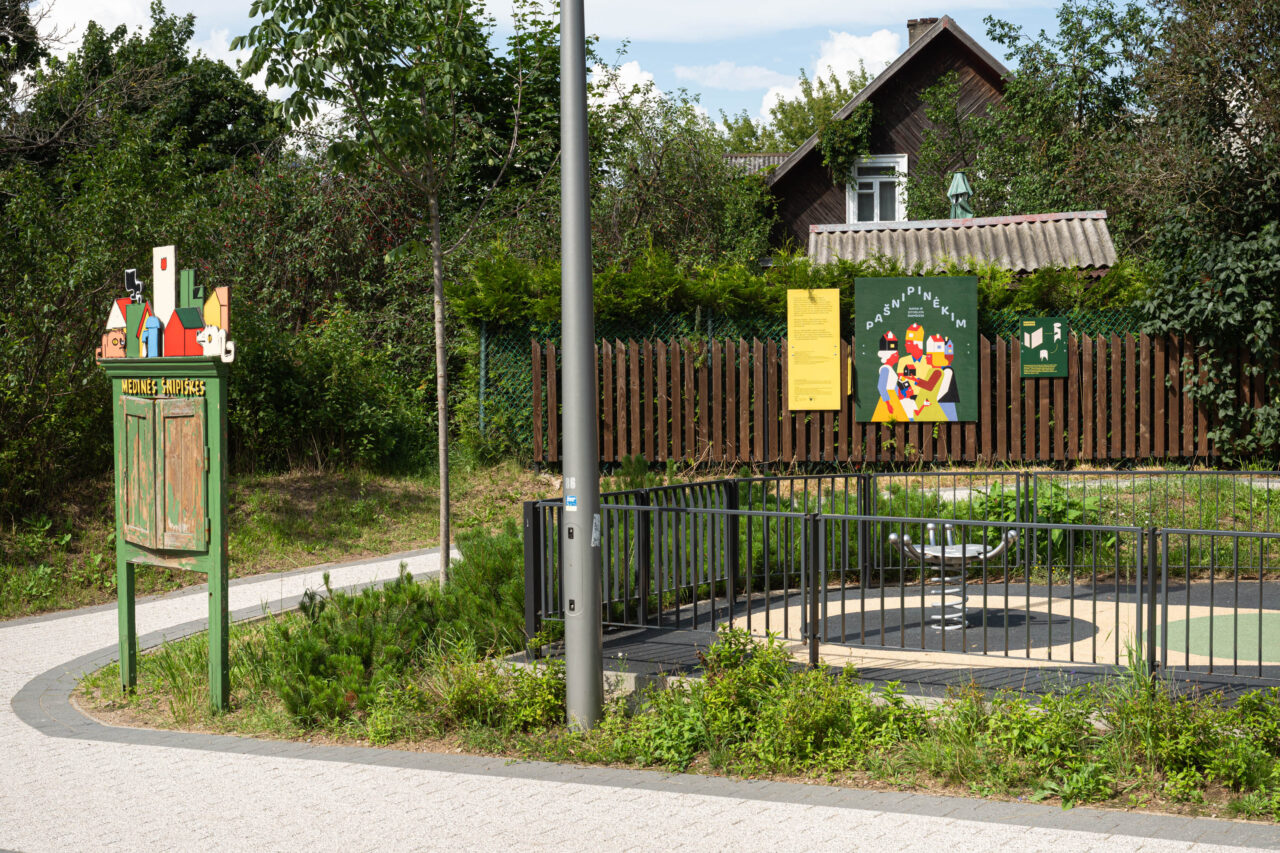
The open-air exhibition on Giedraičiai Street shares stories of the neighbourhood gathered during a summer workshop organised by the Vilnius Museum and the Wooden Architecture Center. Swords, whistles, decks of cards, tiles, clay decorations, old house number plates, family photographs of Šnipiškės gardens, and many other items were presented together with their stories and meanings.
The exhibition design was developed in collaboration with local artist Staselė. Her visuals guided the concept: simple plywood boards, chosen in reference to the wooden architecture of the neighbourhood. The panels are double-sided, with the reverse side emphasising that the exhibition is meant not only for passersby but also for the residents who lent their fences for the display. UV printing was selected to help reduce the sustainability footprint.
Finally, the exhibition was designed to remain in the neighbourhood after the event. The panels will be transformed into stools inspired by details of wooden houses and used in the Wooden Architecture Center.
The exhibition is organised by the Vilnius Museum and the Wooden Architecture Center.
Exhibition design by Ieva Šimkonytė, graphic design by Goda Kairiūkštytė, iliustrations by Staselė Jakunskaitė, installation by Optimum Solution.
Photographer: Gintarė Grigėnaitė
The window display continues the outdoor exhibition in the wooden Šnipiškės neighbourhood. It showcases community artefacts collected during the project’s workshop stage. Local residents contributed historical items and shared their stories with the Vilnius Museum and the Wooden Architecture Center, which moved into the neighbourhood for a summer weekend. A sword, a deck of cards, and a clay ornament are now safely displayed in the heart of Vilnius, inviting passersby to venture into Šnipiškės. There, the outdoor exhibition presents stories of other treasured objects preserved in the area and offers deeper insights into the neighbourhood’s history.
The exhibition is organised by the Vilnius Museum and the Wooden Architecture Center.
Window display designed by Ieva Šimkonytė, graphic design by Goda Kairiūkštytė, iliustrations by Staselė Jakunskaitė.
Photographer: Gintarė Grigėnaitė
Visualisations: Ieva Šimkonytė
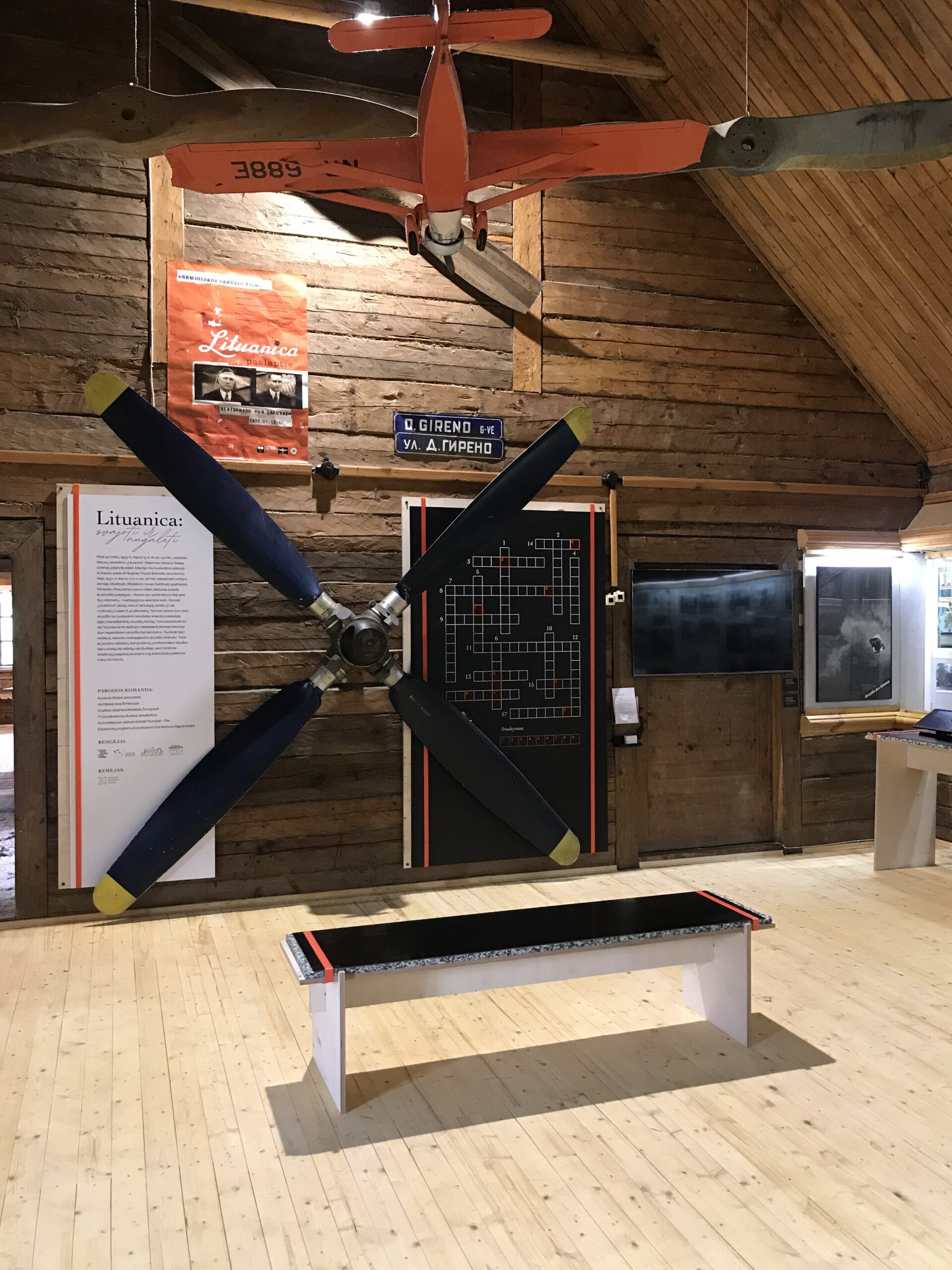
The travelling exhibition „LITHUANICA: To Dream and To Conquer“ commemorates the 90th anniversary of the flight across the Atlantic Ocean by Steponas Darius and Sasys Girenas. The exhibition tells the story about one of the most important events of the 20th Century Lithuania: the flight across the Atlantic in 1933, and the release of the film „The Flight Across the Atlantic“ in 1983, directed by Rimundas Vabalas.
Darius and Girenas were terminated to cross the Atlantic, flying from New York Floyd Bennett Airoport to Kaunas. On July the 15th 1993, 4:24 PM they took off from New York. Unfortunately, the plain crashed (in current Polish territory) when there were only 650 km left to the destination. They flew 6 411 km uninterruptedly for 37 hours and 11 minutes. This was the second longest uninterrupted flight in the history at the time. Such dedication to making the name of the homeland famous has led to a great and undying attention in Lithuania to this legendary flight and pilots.
“Flight Across the Atlantic is the most popular Lithuanian feature film in the history of Lithuanian cinema: in the 1980s, it was seen by more than 647 000 viewers, i.e. about one in five Lithuanians at the time.
Exhibition team:
Curator: Nideta Jarockienė
Exhibition Designer: Ieva Šimkonytė
Graphic Designer: Modesta Žemugalytė
IT Coordinator: Audrius Janulevičius
Production: MB “Montažo fėjos”
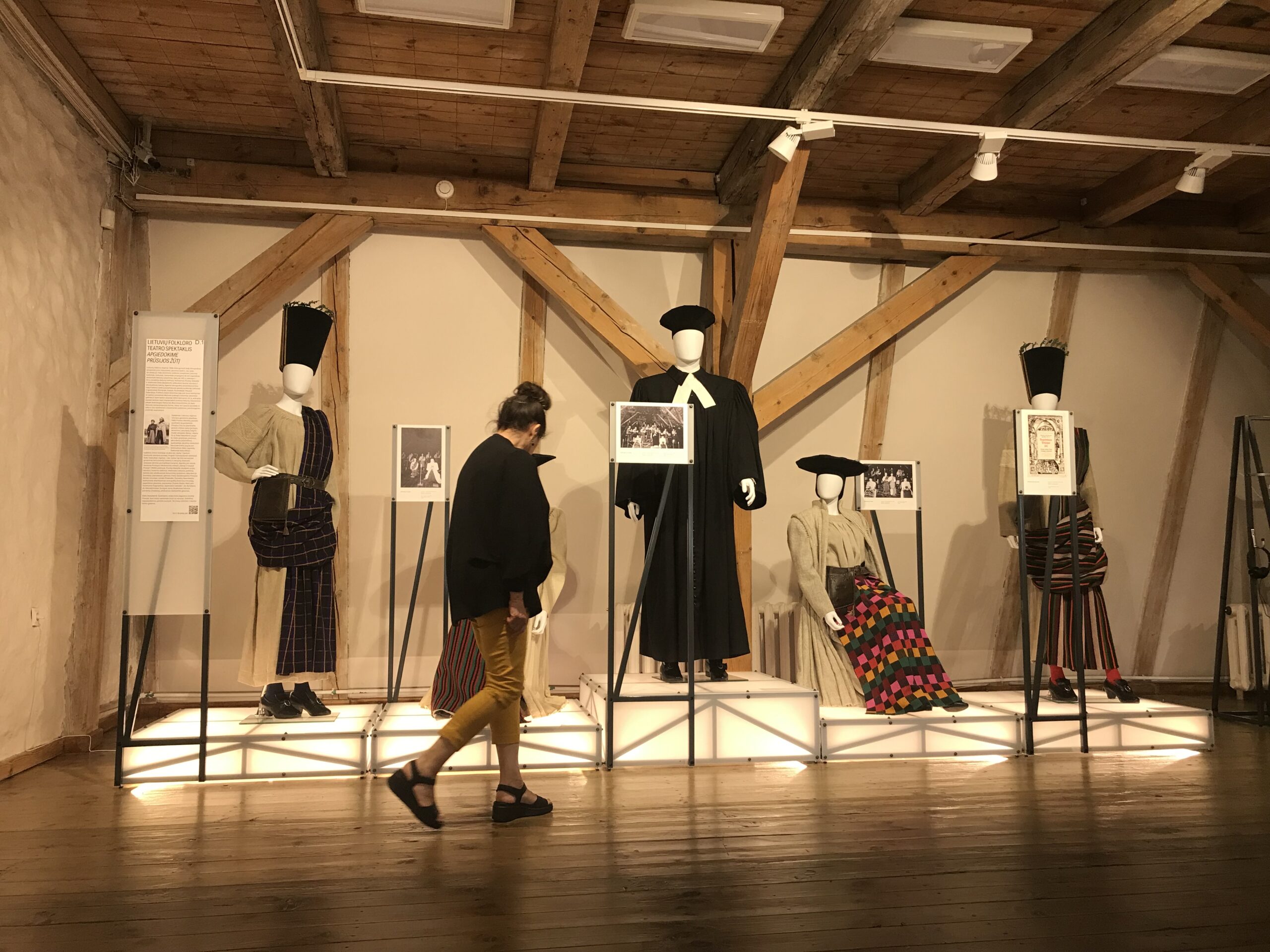
‘The exhibition is based on the Lithuanian Folklore Theatre’s play – the mourning rituals in memory of the Baltic Knights, Let’s Mourn the Fall of Prussia (written and directed by Povilas Mataitis, scenography and costume designer Dalia Mataitienė). The premiere of the play took place on 15th of July 1989, on the day of the 579th anniversary of the Žalgiris Battle. The Prussian costumes recreated by Dalia Mataitienė, have no analogues not only in Lithuania, but also in the whole world, testify to the uniqueness of the Prussians and their high spiritual culture.’
By curator V. Vareikis
Exhibition design is a contemporary interpretation of the original scenography. It references design structures that were used in the play, changing its materiality to contrast with the exhibition space and make the the costumes and their colourful patterns stand out.
Exhibition team:
Curator: Vygantas Vareikis
Project Manager: Janina Aemonaitė
Exhibition Designer: Ieva Šimkonytė
Graphic Designer: Vilmantas Žumbys
Production: MB ‘Montažo fėjos’
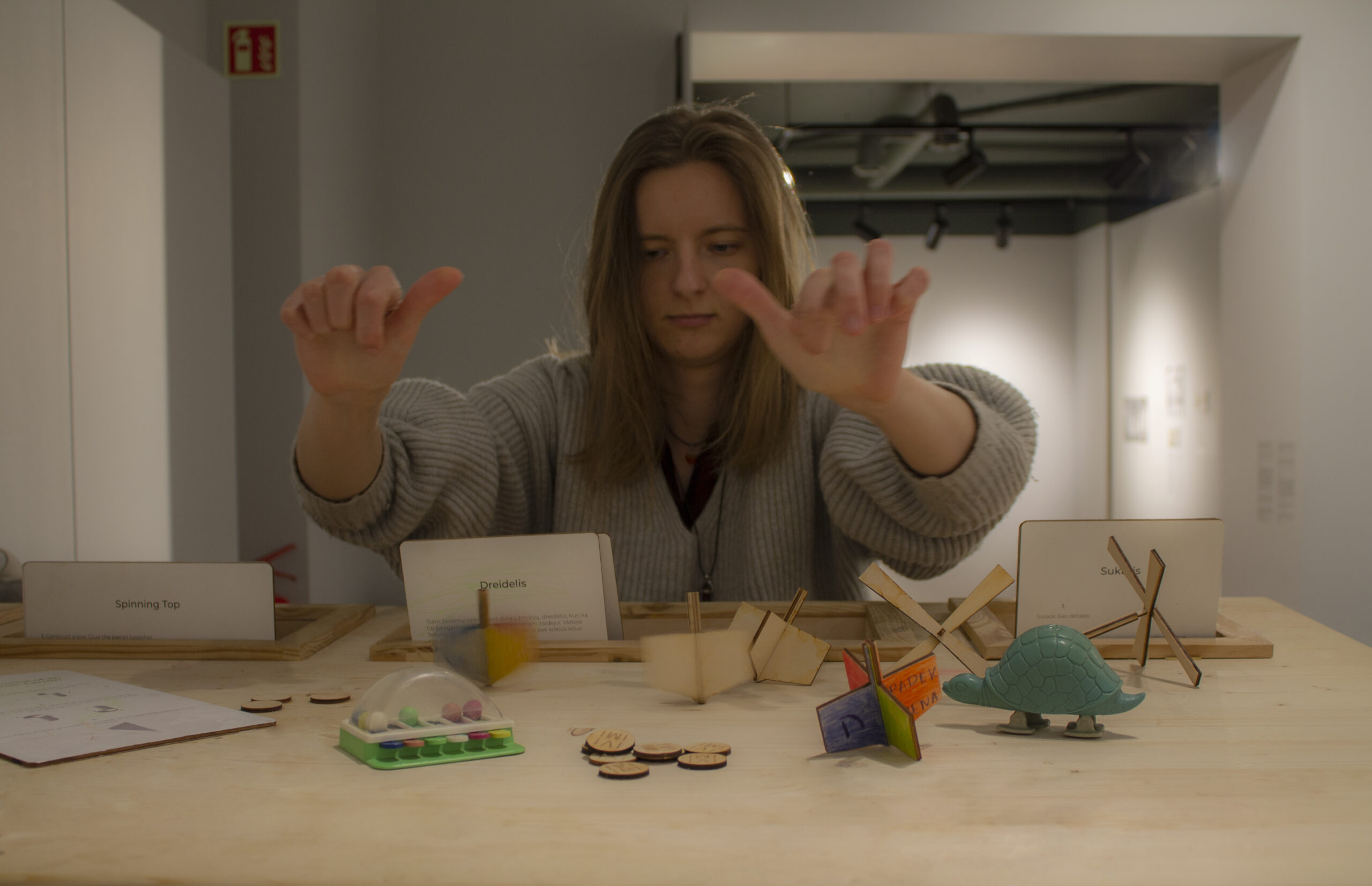
VILNIUS MUSEUM 2022
The exhibition presents the history of German Street, where Vilnius Museum is located. Part of the exhibition is dedicated to childhood history: starting from toys that were found during archaeological excavations to more recent childhood memories of the street’s inhabitants.
Interactive area for kids and families encourages to learn about history through making and playing. Lithuanian childhood history has a long tradition of hand-made toys that were crafted by parents or children themselves. We invite visitors to construct and customise their own toys as well as learn the games that German Street inhabitants use to play in the 14th – 17th Centuries.
Pictures by Ieva Šimkonytė
—
Exhibition curators: Martynas Jakulis, Viktorija Kurienė, Jurgita Verbickienė, Aelita Ambrulevičiūtė, Rasa Antanavičiūtė, Povilas Andrius Stepavičius
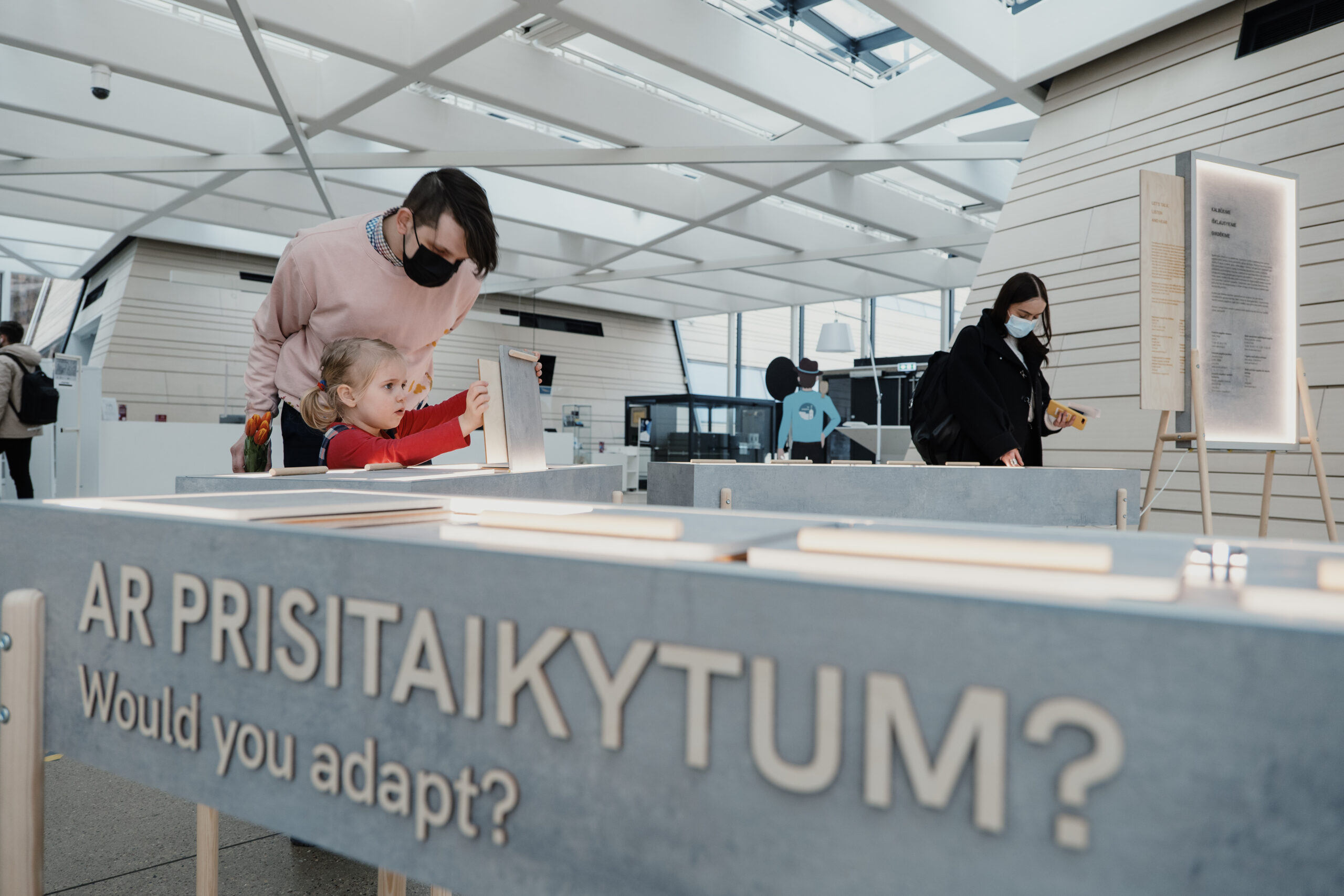
IDENTITY ON THE LINE 2022
The project explores European migration processes and their long-term consequences. Lithuanian local exhibition presents painful stories of Jewish women who left their families and joined partisan troops in the forests during WW2. Narratives are explored through survivors, their daughters, and granddaughters’ perspectives, emphasizing how traumatic experiences affect generations to come.
Sensitive content posed a challenge, especially presenting the travelling exhibition at schools for younger audiences. This was addressed by offering different levels of depth that let visitors decide whether they feel comfortable with listening to the most disquieting parts of the painful past.
Exhibition design aims to create a sense of intimacy and compassion towards the survivors while asking how we can create safe environments for women to share their stories and start the healing process.
Pictures by Justinas Aukšelis (Vilnius University)
— –
Curators: Donata Armakauskaitė and Neringa Latvytė

VILNIUS MUSEUM 2021
Children’s city is an interactive urban planning game that presents the city planning process.
The game raises some questions: How do buildings appear in the city? Who builds them? Who decides how a building will look? Do city structures respond to the needs of the city’s inhabitants? And how can we adapt the city to various groups of people making it functional and inclusive for everyone?
The game aims to educate and include the young generation of museums visitors and create a new outlook on the city planning culture.
Pictures by Vilnius Museum / Ieva Šimkonytė
—
Exhibition curators: Rasa Antanavičiūtė and Marija Drėmaitė
Illustrator: Vanda Padimanskaitė